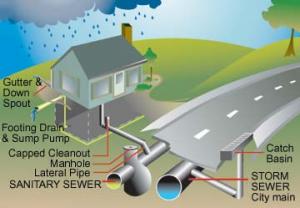-
About Homer
-
- Americans with Disabilities Act Compliance Program City Campgrounds Community Recreation Hickerson Memorial Cemetery
- Library Parks & Trails Public Safety Fire Police Emergency Information
- Events & Activities City Calendar Library Calendar Recreation Calendar Doing Business in Homer Sister City Program Coast Guard City
-
- Departments
- Government
- How Do I?
Illegal Connections to Sanitary Sewer System Affects Us All
Illegal roof drains, sump pumps, and foundation drains connected to the City’s sanitary sewer system sends groundwater to the sewer treatment plant, consuming expensive wastewater treatment capacity. Property owners need to disconnect these prohibited connections or be willing to pay for future treatment plant expansions.
The City of Homer Public Works Department conducted a field study in residential areas provided with sewer service. The study was conducted during the summer of 2006 with a goal of improving efficiency of the wastewater collection system by identifying sources of infiltration and inflow. Infiltration is defined as groundwater that slowly seeps into the sewer collection system through leaking pipes and manholes. Inflow rapidly flows into sewers via roof drain downspouts, foundation drains, sump pumps, storm drain cross-connections, and through holes in manhole covers.
The study concluded that the high flows at the sewer treatment plant, experienced during wet weather, can be attributed more to inflow than infiltration. Public Works has re-grouted manholes, slip-lined aging pipe, and installed water proof pans under sewer manhole lids to minimize infiltration/inflow. The study concluded that previous violations of EPA sewer treatment plant discharges to Kachemak Bay are most likely due to illegal connections (roof drains, footing drains, and sump pumps) that direct groundwater into the sewer system. This groundwater does not need to be treated in the same manner as wastewater and should not be directed to the treatment plant.
The plant is sized to treat the volume of domestic and commercially produced sewage generated by the community; directing groundwater to the plant utilizes plant capacity that was intended to deal with wastewater. In the future, as wastewater flow increases due to growth, additional capacity will need to be provided just to handle groundwater flows. Elimination of groundwater inflow will extend the useful life of the plant and postpone expensive sewer treatment plant expansions.
What can you do?
• Familiarize yourself with your house plumbing system. If you have roof downspouts that are piped underground, a sump pump that has no identifiable discharge point, or foundation drains that don’t discharge to the road side ditch or other low point on the lot; you may be contributing to the problem.
• Disconnect unlawful connections to the sewer system. Contact Public Works to help you find reasonable alternatives.
• Appreciate that the community’s cost of treating wastewater will be reduced if only wastewater is directed to the sewer system.
What can the City do?
• Continue eliminating infiltration and inflow on sewer trunk and interceptor sewer mains.
• Initiate smoke and dye testing of private on-property sewer lines to identify existing unlawful connections that contribute to inflow.
• Amend Homer City Code to provide penalties for illegal connections.
• Implement inspections of newly constructed sewer connections to prevent new unlawful connections.
• Educate the community on the costs of these prohibited connections to the sewer system.



